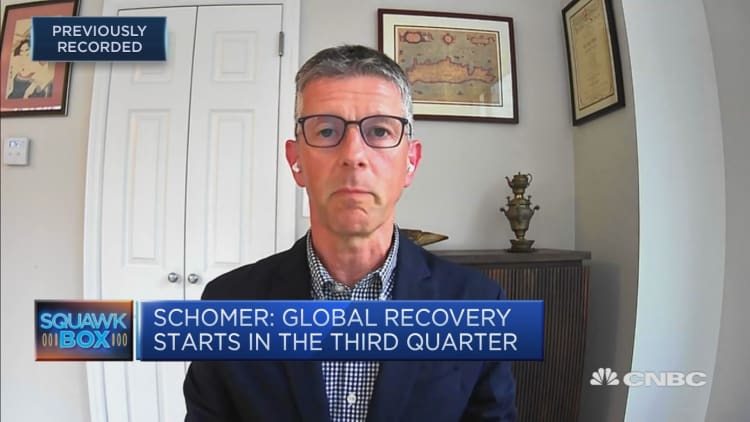BEIJING – China's central bank isn't planning much more stimulus for the country as its economy recovers from the coronavirus shock, policymakers said.
"(Some recent) policies and measures were made in response to the coronavirus outbreak, and once they completed their mission they have exited," Guo Kai, deputy director of the monetary policy department of the People's Bank of China, told reporters on Friday. That's according to a CNBC translation of his Mandarin-language remarks.
As an example, he pointed to two special loan programs worth a combined 800 billion yuan ($114.29 billion) that had completed their respective purposes of supporting production of medical supplies and resumption of work.
"In the next half of the year, the economy will return to normal, and the role of traditional monetary policy may become more obvious," Guo said at the press briefing. "We have entered a more normal state."

During the first three months of the year, China's economy contracted by 6.8% after more than half of the country extended a Lunar New Year holiday shutdown by at least a week in February in an effort to limit the spread of Covid-19. The disease first emerged late last year in the Chinese city of Wuhan.
The outbreak stalled within the country by mid-March, while accelerating its spread overseas in a global pandemic that has since infected more than 12.8 million people worldwide and killed more than 567,000 people. The world economy is expected to fall into a recession this year as other governments have limited social gatherings. That drop could significantly affect demand for exports from China, which is still generally expected to eke out national growth this year.
The central bank's statistics department head Ruan Jianhong said Friday that out of 10,000 enterprises surveyed nationwide, 90.7% of those in the services industry had reopened as of June 15. For those in industrial work, utilization of equipment was at least the same as the average level of the second quarter last year, Ruan said.
China is set to release second-quarter GDP and other key economic data this week.
"Right now, we put greater emphasis on the word 'moderate,'" Guo said, pointing to considerations about future changes to the credit supply and prices.
PBoC data released Friday showed that amid the height of the coronavirus outbreak in the first half of this year, Chinese banks loaned a record high 12.09 trillion yuan, which Reuters pointed out is roughly equivalent to Canada's GDP.
"(We must) recognize that appropriately lowering interest rates doesn't mean the lower, the better," Guo said. "If rates are far too low … that may cause a problem of capital flowing to where it shouldn't."
Vigilance on global capital flows
While other major central banks in the world have cut rates to near zero, the PBoC has been relatively restrained. By early July, the difference between the U.S. 10-year Treasury yield and that of the 10-year Chinese government bond was the greatest since 2012, Macquarie's Chief China Economist Larry Hu pointed out in a report earlier this month.
Given the opportunity for relatively higher returns, more foreign capital has flowed into Chinese investment assets. Last week, the mainland Chinese stock market also soared more than 7%, as local investor optimism surged amid some state-backed media reports that spoke well of the market.
"A high level of vigilance is needed in the short term for large-scale capital flows," research director Wang Xin said at the same press briefing on Friday.
"Major central banks (such as in) Europe and the U.S. have enacted very strong monetary policy, which may cause short-term capital flows around the world in a large scale," he said. "We have seen, some new economies have already been hit by the shock of short-term capital flows, and may even see financial risks."
The PBoC's reserved tone on further stimulus for China comes as the country has been trying to reduce its reliance on high debt levels, while maintaining economic growth. Data released Friday showed significantly greater use of direct financing channels such as from stocks, while loan growth continued.
Nomura's Chief China Economist Ting Lu said in a note Friday he expects credit could rise further in coming months given government budget needs. "We expect the PBoC to maintain its policy easing stance through the remainder of this year as the economy is still far from a full recovery and faces heightened uncertainty," he said.
"However, the People's Bank of China (PBoC) may postpone some previously planned monetary easing measures, especially those high-profile ones such as reserve requirement ratio (RRR) cuts and medium-term lending facility (MLF) rate cuts, given the recent stock market rally," Lu said. "We believe the probability of the PBoC cutting its benchmark deposit rate now appears to be close to zero."


